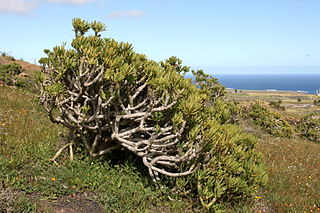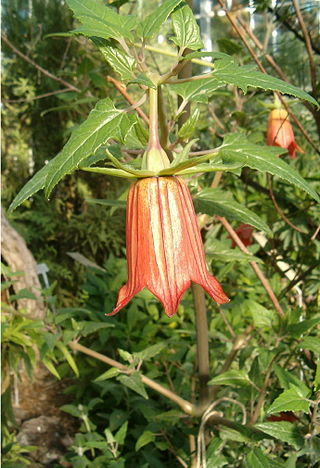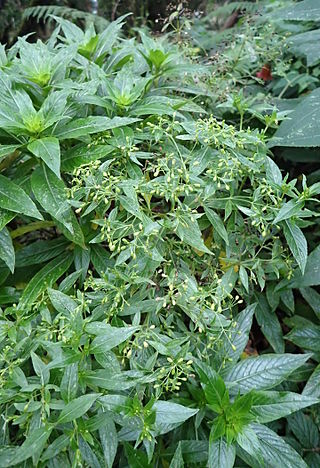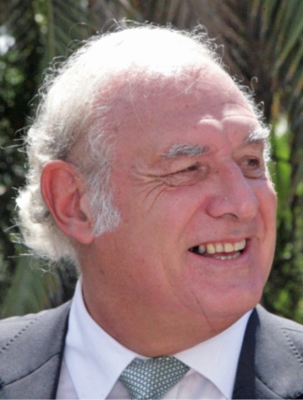
Argyranthemum is a genus of flowering plants belonging to the family Asteraceae. Members of this genus are sometimes also placed in the genus Chrysanthemum.

Euphorbia atropurpurea, called tabaiba majorera or tabaiba roja in Spanish, is a shrub in the family Euphorbiaceae native to Tenerife in the Canary Islands. It can reach 2 metres in height, and grows in ravines, and on slopes and terraces.

Aeonium nobile is a succulent, subtropical flowering plant in the family Crassulaceae. It is native to the island of La Palma in the Canary Islands, where it grows on dry slopes and cliffs at altitudes up to 800m. The inflorescences are large and spreading with bright red flowers.

Kleinia neriifolia, known in Spanish as verode or berode, is a species of flowering plant in the daisy family (Asteraceae). It is endemic to the Canary Islands. It was formerly named Senecio kleinia.

Euphorbia bourgaeana is a species of flowering plant in the spurge family Euphorbiaceae. It is native to Tenerife in the Canary Islands.

Euphorbia canariensis, commonly known as the Canary Island spurge, Hercules club or in Spanish cardón, is a succulent member of the genus Euphorbia and family Euphorbiaceae endemic to the Canary Islands. It is the plant symbol of the island of Gran Canaria.

Hypericum canariense is a species of flowering plant in the family Hypericaceae known by the common name Canary Islands St. John's wort. It is the sole member of Hypericumsect. Webbia.

Descurainia bourgaeana is a species of flowering plant in the family Brassicaceae endemic to Las Cañadas del Teide on Tenerife and La Palma in the Canary Islands.

Aeonium ciliatum is a species of flowering plant in the family Crassulaceae that produces large green leaf rosettes, which can be 50 centimetres (20 in) across. The rosettes emerge from a woody stem that branches freely and can become very top heavy. It is endemic to Tenerife in the Canary Islands, where it prefers some shade, and is frequent in the Anaga peninsula in the north east of the island.

Aeonium hierrense is a species of succulent flowering plant in the family Crassulaceae that is endemic to the island of El Hierro in the Canary islands. It has whorls of strongly ciliate leaves borne on a stem up to 1m in height. The leaves takes on an attractive purple colour during the summer, being quite green in the winter. It produces whitish pink flowers that have 8-fold symmetry.

Aeonium canariense is a species of flowering plant in the family Crassulaceae. It is endemic to the island of Tenerife in the Canary Islands, where it grows on dry slopes and cliffs in the north of the island from sea level to about 1300m. It forms large rosettes of leaves close to the ground but the spikes of yellow flowers stand up to 70 cm tall.

Aeonium urbicum is a succulent species of flowering plant in the family Crassulaceae. It is endemic to Tenerife, one of the Canary Islands, where it grows on the north of the island from Teno point to the Anaga peninsula. Until 1999, it was also considered a resident of La Gomera, another Canary Island, but that year the populations on that island were considered a new species and named Aeonium appendiculatum.

Globularia ascanii is native to Gran Canaria island of the Canary Islands archipelago.

Canarina canariensis is a species of flowering plant in the bellflower family Campanulaceae, commonly known as the Canary Island bellflower, and known locally as bicácaro.

Sonchus acaulis is a plant species in the tribe Cichorieae within the family Asteraceae. It is found only on the Canary Islands of Gran Canaria and Tenerife.

Aeonium sedifolium is a perennial flowering plant in the stonecrop family Crassulaceae. The plant is native to the western Canary Islands of Tenerife, La Gomera and La Palma.

Plocama pendula is a species of flowering plant in the coffee family Rubiaceae, endemic to the Canary islands. It is a shrub growing up to 2 m, with filiform and minute flowers grouped near the tips of slender, pendulous branches. The fruit, a berry, is black.

Phyllis nobla is a small, glabrous or pubescent subshrub in the family Rubiaceae.

David Bramwell MBE was an English botanist and taxonomist, director of the Jardín Botánico Canario Viera y Clavijo, Gran Canaria (1974–2012), and active in the conservation of insular floras.

Aeonium lancerottense is a species of succulent flowering plant in the family Crassulaceae that is endemic to the island of Lanzarote in the Canary islands.




















